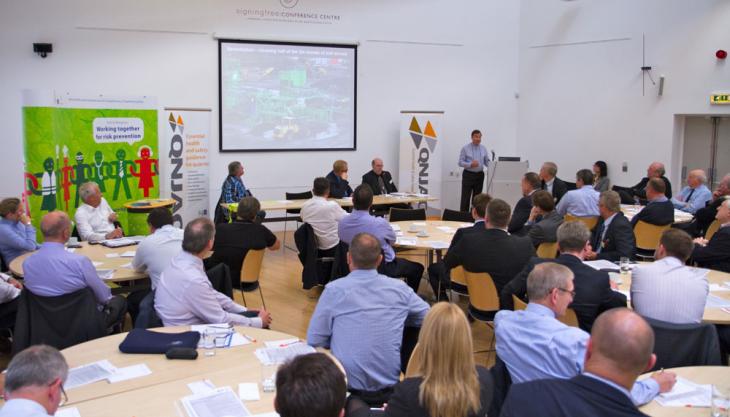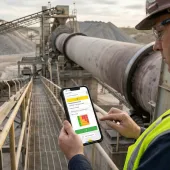Workforce engagement initiative launched by QNJAC

New initiative aims to encourage employers to focus on new ways of getting staff more involved in workplace safety
DESPITE the outstanding success of the accident-reduction measures that started with the ‘Hard Targets’ initiative in 2000, concerns have been voiced recently that the improvements in the industry’s performance seem to have reached a plateau and stalled in the last couple of years or so.
In addition, whilst the minor incident rate in the extractive industries is now comparable with the average for the rest of British industry, major accidents are three times the average and the frequency rate for fatalities in quarries and mines is no less than 20 times the norm.
Against this background, a one-day event organized by the HSE Workforce and Leadership Team and funded by EU-OSHA (European Agency for Safety and Health at Work) took place at the Signing Tree Conference Centre in Birmingham on 6 November to launch a new initiative aimed at encouraging employers to focus on new ways of getting their staff, especially hourly paid workers, more involved with the overall process of workplace safety.
Delegates were welcomed to the event by Colin Mew, Head of National Quarries Inspection Team, and, reflecting the theme of ‘In this together’ the day was co-chaired by Malcolm Mellow, Unite safety advisor and chair of QNJAC Worker Participation Group, and Colin Jenkins, President of the Institute of Quarrying.
In a further demonstration of the industry’s commitment to its SHE objectives, the event was very well supported by around 100 participants, the majority of whom were senior managers from operating companies.
The morning session comprised three presentations, the first of which was given by Lawrence Waterman, head of health and safety for the Olympic Delivery Authority and the London Legacy Development Corporation.
During the course of an inspirational talk, he explained how a large, complex and contaminated 260-hectare site in the East End of London had been transformed into a sporting showcase in a relatively short period of time without any of the 50,000 workers involved in the construction phase losing their life.
Apart from achieving zero fatalities, the accident frequency rate for the project was 0.1 – the best ever achieved for a major project in the UK. He went on to explain that the creation of a very strong safety culture had been fundamental to this success, based on strong leadership and the promotion of an understanding of the need for responsible personal behaviour throughout the whole workforce.
Mr Waterman emphasized the key role played by the supervisor in the safety management process and also the value of the various ‘Reward and Recognition’ schemes that had been put in place on site to reinforce good behaviour.
The second presentation was given by well-known safety consultant Nigel Bryson, whose basic message was that, in safety terms, workers had to be seen as the solution and not the problem. In emphasizing that leadership was needed in every aspect of business, as one positive way forward in a workforce-engagement plan he recommended that both managers and safety reps take part in the same training programmes.
Mr Bryson also referred to the need for a ‘fair blame’ policy, a willingness to suspend work if safety standards are not met, and the need to involve workers in the development of risk assessments.
As both the safety goals and some of the means to achieve them had been identified, the next talk, given by Victoria Bennett, senior psychologist at the Health and Safety Laboratory (HSL), covered some of the tools and techniques available to help employers’ measure and monitor their safety performance.
In posing the question ‘What does it mean to engage?’ she explained that direct worker involvement in decision-making was essential to gain effective workforce engagement. To this end, HSL has developed a number of resources, such as the Safety Climate Toolkit, which could be used to take a snapshot of the level of workforce engagement at a given point in time.
The afternoon session took the form of an open meeting of QNJAC (Quarries National Joint Advisory Committee) itself and was chaired by Mike Cross in his final week as Head of Operations, Construction and Quarries, HSE. In this session Mike Phillips, chair of the QNJAC Communications Working Group and general manager of the Institute of Quarrying, outlined the progress that was being made in creating a clearer identity for QNJAC and a better understanding of the work that it does.
This had started with the creation of a distinctive logo and the next step will be the launch of a mobile App which will provide access to the technical guidance that is being generated by the various working groups. It was explained that a further objective is to convert the content of the guidance notes into resources, such as PowerPoint presentations, which could be made available for CPD purposes at meetings, seminars and training courses throughout the industry.
On behalf of the HSE, Rob Vondy, Head of Workforce and Leadership Policy, gave a summary of the themes that had been addressed in the morning meeting and drew attention to the requirement for ‘visible felt leadership’; the engagement of managers, supervisors and team leaders; and the need to listen to the voice of the employees.
Roy Bush, HM Inspector of Quarries, provided an update on the current progress being made by each of the QNJAC working groups and went on to draw attention to current trends by presenting a series slides which provided a graphic illustration of the slowdown in the industry’s accident-reduction performance.
The final comment came from HSE board member David Gartside, who commended the industry on its achievements to date, but reminded those present that the severity of the injuries that were still occurring left no room for complacency and every reason for employers to explore creative means of workforce engagement in pursuit of the Target Zero objective.
The final session of the day consisted of an open discussion centring on the challenges facing the industry in its quest to address the issue of effective worker participation as part of the process of getting the industry accident statistics back on to a downward path.









